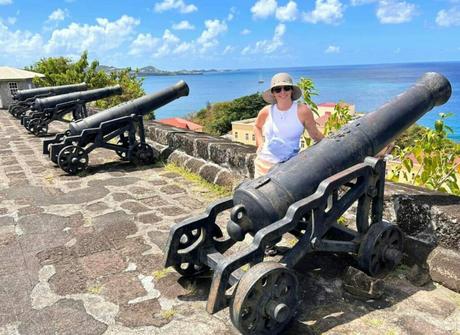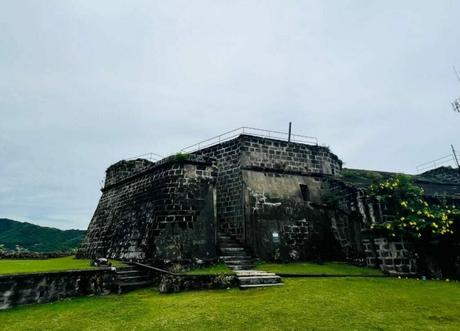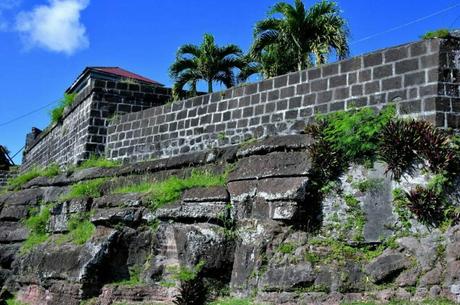Discover the captivating stories of Grenada’s historical forts and sites that whisper secrets of a bygone era.
Nestled atop a hill in St. George’s, Fort George stands tall, offering panoramic views of the city’s colorful buildings and turquoise Caribbean Sea. Nearby, Fort Frederick’s forward-thinking design speaks of lessons learned from past military failures, while its ramparts provide a serene escape with stunning views of the island. Venture to Fort Matthew, an eerie reminder of Grenada’s military and psychiatric history, where underground tunnels hold tales of old.
For a taste of Grenada’s authentic heritage, visit the River Antoine Estate Rum Distillery, where centuries-old methods still produce the famous Rivers Rum. And if you seek a blend of history and nature, Belair National Park’s lush landscapes and well-preserved plantation house invite you to step back in time while exploring the island’s rich biodiversity.
Fort GeorgeSt. George’sStrategic defense in conflicts1705Preserved
Fort FrederickRichmond HillNamed after Prince Frederick1779Ruins
Fort MatanzasGouyaveHistoric conflict site1735Restored
Fort VictoriaSt. Mark’sCoastal defense1806Preserved
Fort LucasSt. David’sCoastal defense1770Ruins
Fort MatthewSt. John’sFormer prison and signal station1779Preserved
Whether you’re a history enthusiast or a nature lover, Grenada’s historical forts and sites promise an enthralling journey through time and culture.
Fort George

In Grenada’s capital city of St. George’s, on top of a hill, stands the majestic Fort George, a monument to the island’s long history. Having been constructed by the French in 1705, it is not only the oldest fort in Grenada but also one of the best preserved in the Caribbean. From the battlements, you can see the colorful Georgian buildings of the city, the horseshoe-shaped harbor, and the Caribbean Sea in the distance.
Walking through Fort George is like stepping back in time. The old cannon placements, barracks, and powder magazines provide a stark reminder of the island’s turbulent past. Despite the passage of time, one can almost hear the echoes of battles fought, of the French and British who laid claim to the island, and of the indigenous people who first called it home.
In 1983, this historical site was the setting of a tragic modern event—the execution of Maurice Bishop, the charismatic Prime Minister of Grenada. Today, a plaque commemorates his life, adding a poignant layer to the fort’s extensive historical narrative.
Visitors to Fort George should also be sure to explore the adjacent police station. Its exhibition room features historical photos and artifacts that further enrich the story of Grenada and its people.
Fort George isn’t just a historical site. It’s a compelling storyteller, narrating centuries of change, conflict, and community through its enduring stone walls.
Fort Frederick

Situated atop Richmond Hill, Fort Frederick offers arguably the most breathtaking views in all of Grenada. Built by the French following their capture of the island from the British in 1779, the fort’s unique design is a silent testament to the lessons learned from past military failures.
Despite being constructed for warfare, Fort Frederick’s cannons have never fired a shot in battle. This lack of combat history is attributed to its forward-thinking design. The fort is oriented inland, a stark contrast to most forts of the period that faced the sea. This unusual configuration was a reaction to the British recapture of the island in 1779, which was executed from the landward side.
The fort’s construction and history aren’t its only draw. The vantage point from Fort Frederick provides unobstructed views of St. George’s, the neighboring parishes, the stunning Grand Etang Lake, and even the sister island of Carriacou on clear days.
Visitors often find a walk around the fort’s ramparts to be both scenic and serene. Inside, the fort’s buildings are still mostly intact, and you can explore rooms that once served as soldiers’ barracks and storage rooms for ammunition.
Fort Frederick’s peaceful atmosphere today belies its turbulent past, serving as a reminder of the impermanence of conflict and the enduring beauty of the island itself.
Fort Matthew

Fort Matthew beckons history lovers with its dark and intriguing past. This fort serves as a somber reminder of Grenada’s military past and is hidden away in the hills outside of St. George’s. It was initially built by the French in the late 18th century as a defensive fortification and afterwards used as a mental institution. As a result, it shows the scars of its turbulent past.
The structure, now in ruins, houses a network of underground tunnels, once used by soldiers for quick and secure movement within the fort. Exploring these can provide an adventurous twist to your historical exploration. Carrying a flashlight is recommended as you navigate these shadowy passages, where stories of old echo in the silence.
Fort Matthew’s history took a darker turn in the 20th century when it was repurposed as a mental asylum. Its patients were confined in the underground tunnels, and remnants of their time here are still visible, adding a somber tone to the fort’s history.
Despite its grim past, Fort Matthew offers a unique perspective on Grenada’s history, one that differs from the standard narratives of colonialism. The fort’s partial ruins stand as a testament to the passage of time and the resilience of history, even in its most tragic forms.
The view from Fort Matthew is another major draw. The vantage point offers sweeping views of the capital and the azure Caribbean Sea, providing a serene contrast to the fort’s unsettling history. The juxtaposition is a stark reminder of Grenada’s ability to balance its turbulent past with its vibrant present.
River Antoine Estate Rum Distillery

A journey into Grenada’s history wouldn’t be complete without visiting the River Antoine Estate Rum Distillery. Dating back to 1785, it’s the oldest functioning water-powered distillery not just in Grenada, but in the entire Caribbean.
The distillery still uses its original methods to produce its famous Rivers Rum. From the crushing of the sugarcane with water-powered mills to the fermentation in wooden vats and distillation in traditional pot stills, the process is a living demonstration of historical manufacturing techniques.
While it’s a treat to see this time-honored process, tasting the rum is an experience in itself. Rivers Rum is potent, typically distilled at a high proof. It is a taste of the Caribbean in its purest form and has a robust, unrefined flavor that is perfect for anybody looking for an authentic experience.
Additionally, the estate provides guided tours that walk visitors through each stage of the rum-making process. You can see the time-tested techniques, tender love, and straightforward creativity that have been used to manufacture each bottle for more than two centuries as you stroll through the grounds.
The River Antoine Estate Rum Distillery isn’t just a distillery—it’s a living museum, preserving and showcasing a piece of Grenada’s heritage with every drop of rum it produces.
Belair National Park

Belair National Park is the place to go if you’re looking for a more authentic historical experience. This enormous park is home to a surprising variety of landscapes, such as dense rainforests, serene beaches, rolling meadows, and steep slopes.
The early 18th-century old Belair plantation is where the park’s focal point is. Grenadian history has changed on the plantation over time, from the time of French and British colonialism to the present. The well-preserved plantation mansion offers an insight into a bygone period with its classic architecture and antique furniture.
In addition to being significant historically, Grenada’s distinctive flora and wildlife may be found in abundance at Belair National Park. The park’s unique environment will excite nature lovers as you can see rare bird species, amusing monkeys, and even the occasional armadillo there.
The park also offers a number of hiking trails that take visitors through varied landscapes and offer a variety of experiences. Walking through the dense forest, climbing the mountainous terrain, or simply unwinding on the serene beach, the natural beauty is amazing.
Belair National Park is more than simply a magnificent green space; it is a living representation of the island’s rich natural and historical legacy, making it a must-see for any tourist to Grenada.
FAQ

How many forts does Grenada have?
Grenada boasts several historical forts that bear witness to its rich past. The exact number of forts varies, but notable ones include Fort George, the oldest and best-preserved in the Caribbean; Fort Frederick, offering breathtaking views of St. George’s; and Fort Matthew, with its eerie reminders of military and psychiatric history.
What is the history of the fort in Grenada?
The forts in Grenada were strategically constructed by different colonial powers during the 18th century. Fort George, built by the French in 1705, served as a testament to the island’s past conflicts. Fort Frederick, also built by the French, adopted a unique inland orientation to avoid past military failures. Fort Matthew, constructed for defense, later served as a mental asylum, leaving behind a somber history.
What are 4 landmarks in Grenada?
River Antoine Estate Rum Distillery, dating back to 1785, is the oldest functioning water-powered distillery in the Caribbean, preserving Grenada’s rum-making heritage. Belair National Park, home to a historic plantation house, offers a glimpse into the island’s past and diverse ecosystems. Grand Etang Lake, a stunning crater lake, sits nestled within the island’s lush rainforests, captivating nature lovers. The colorful Georgian buildings of St. George’s, Grenada’s capital, adorn the landscape, echoing the island’s colonial history.

